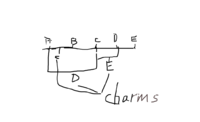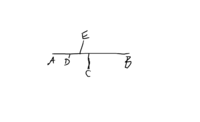eddy2017
Elite Member
- Joined
- Oct 27, 2017
- Messages
- 2,525
hello and warm greetings to professors, tutors, and helpers alike: I need help with this.
A circular bracelet contains 5 charms, A, B, C, D, and E, attached at specific points around the bracelet, with the clasp located between charms A and B. The bracelet is unclasped and stretched out into a straight line. On the resulting linear bracelet, charm C is between charms A and B, charm D is between charms A and C, and charm E is between charms C and D.
Which of these statements is (are) necessarily true?
I. The distance between charms B and E is greater than the distance between charms A and D.
II. Charm E is between charms B and D.
III. The distance between charms D and E is less than the distance of bracelet between charms A and C.
i will go for II, and III because, when i compare that statement with the drawing i made, it checks out.
A circular bracelet contains 5 charms, A, B, C, D, and E, attached at specific points around the bracelet, with the clasp located between charms A and B. The bracelet is unclasped and stretched out into a straight line. On the resulting linear bracelet, charm C is between charms A and B, charm D is between charms A and C, and charm E is between charms C and D.
Which of these statements is (are) necessarily true?
I. The distance between charms B and E is greater than the distance between charms A and D.
II. Charm E is between charms B and D.
III. The distance between charms D and E is less than the distance of bracelet between charms A and C.
- II and III
- None of these is necessarily true
- I, II, and III
- II only
i will go for II, and III because, when i compare that statement with the drawing i made, it checks out.
Attachments
Last edited:


